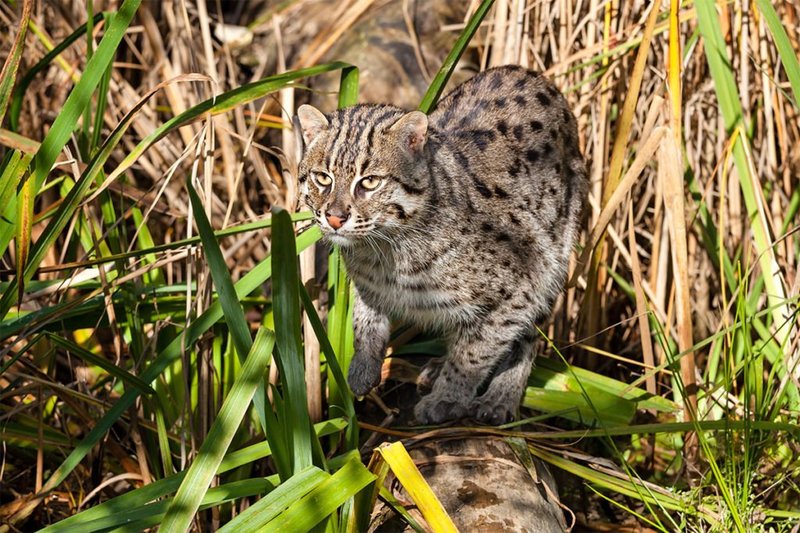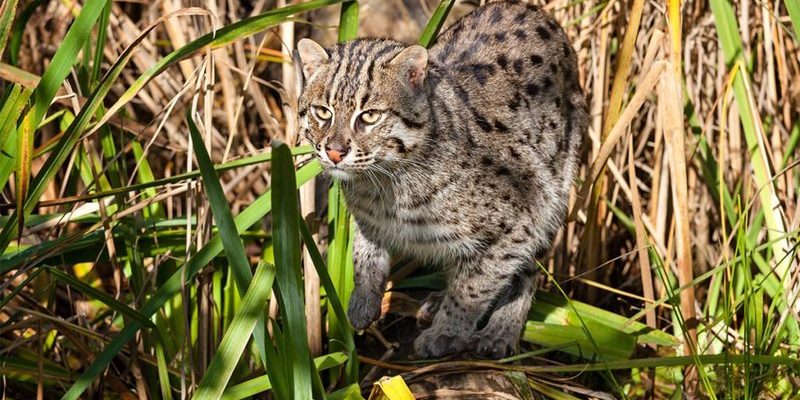
The Fishing Cat is one of nature’s most fascinating creatures. Imagine a cat that thrives in wetland habitats and has a penchant for catching fish! You might picture a fluffy housecat lounging in the sun, but the Fishing Cat is anything but ordinary. With its unique adaptations and behaviors, this wild feline stands out in the animal kingdom. It’s not just about eating fish; it’s about how this bobtail cat has learned to survive in challenging environments. If you’re curious about this magnificent animal, you’re in for a treat.
These cats are primarily found in the wetlands of South and Southeast Asia. They are well adapted to their watery home, with webbed feet that help them paddle through water while hunting. Think of them as the graceful divers of the cat family, blending agility with stealth. Their striking appearance, marked by a sleek, spotted coat, makes them visually captivating. As we delve deeper into the world of Fishing Cats, we’ll explore their habitat, diet, and intriguing behaviors that make them so special.
Habitat and Distribution
Fishing Cats predominantly inhabit areas that offer both water and cover, including marshes, swamps, and riverbanks. Their range extends across parts of India, Bangladesh, and Sri Lanka, reaching as far as Indonesia. The character of their habitat plays a big role in their survival; they thrive in regions with dense vegetation that provides plenty of cover and ample water sources. This preference for wetland environments makes them vulnerable to habitat destruction as human activities expand into these areas.
These cats are quite versatile, often found in various environments as long as water is present. You might find them lounging near lotus ponds or stalking prey near riverbanks. Their ability to adapt to different wetland areas means that they can sometimes be seen at different elevations, from flat river valleys to coastal wetlands, as long as there’s a reliable food source. However, as their natural habitats face threats from urban development and agriculture, the Fishing Cat’s distribution is increasingly restricted, impacting their populations.
Physical Characteristics
The Fishing Cat is a medium-sized wild cat, typically weighing between 11 to 25 pounds. Their size and build reflect their life as semi-aquatic predators. They possess a stocky body, short legs, and, most notably, partially webbed feet. This unique adaptation allows them to swim efficiently—a critical skill for catching fish and navigating their watery homes. Their fur is dense and water-resistant, with a beautiful coat decorated in dark spots that help camouflage them in their natural surroundings.
In terms of appearance, Fishing Cats have a distinctive look. Their fur tends to be grayish-brown with dark spots, which help break up their outline in the reeds. They have large, round faces with expressive eyes that provide excellent night vision, essential for hunting in low-light conditions. Their long tails help with balance, especially when they’re prowling through uneven terrain or making quick turns while chasing prey. Every feature of the Fishing Cat is fine-tuned for its unique lifestyle, making it an incredible example of evolutionary adaptation.
Diet and Hunting Techniques
The Fishing Cat’s diet primarily consists of fish, but they are opportunistic feeders. Their hunting repertoire includes frogs, birds, and small mammals. You might think of them as the fishermen of the cat world, patiently stalking their aquatic prey. They exhibit remarkable hunting techniques, often using their swift paws to strike at fish just below the water’s surface. This behavior showcases their agility and precision—traits honed by their need to survive in a competitive landscape.
They tend to hunt during dawn and dusk, making the most of the low light to catch unsuspecting prey. Unlike other cats that rely heavily on stealth on land, Fishing Cats have learned to adjust their hunting strategies in water. They will often wade in shallow waters, keeping low to the surface while surveying their surroundings. When they spot a target, they can either pounce or use a quick swipe of their paw to catch the slippery fish. Their ability to adapt to different hunting environments illustrates their intelligence and resourcefulness.
Reproduction and Lifespan
Fishing Cats typically reach sexual maturity at around two years of age. Mating occurs mainly during the rainy season, coinciding with the abundance of food. After a gestation period of about 60 to 70 days, the female gives birth to a litter of 2 to 4 kittens. These kittens are born blind and rely heavily on their mother during the early stages of life. As they grow, they learn essential survival skills, including hunting and swimming, from their mother.
Once they are about 6 months old, the kittens begin to venture out with their mother to learn the ropes of hunting. They will stay with her for about a year before becoming independent. In the wild, Fishing Cats can live up to 10 years, though their lifespan can vary due to factors like habitat loss and human interaction. In captivity, they have been known to live longer, showing how important a safe environment is for their well-being.
Conservation Status
The IUCN lists the Fishing Cat as “Vulnerable,” which means that it faces a high risk of extinction in the wild. Habitat loss due to urbanization, agriculture, and climate change poses significant threats to their populations. Wetlands are some of the most threatened ecosystems, and as these areas diminish, so does the Fishing Cat’s home. Conservation efforts are essential to preserve not just the Fishing Cat, but also the ecosystems they inhabit.
Various wildlife organizations are working towards increasing awareness and protecting critical habitats for the Fishing Cat. These efforts include habitat restoration and community education programs. By raising awareness about the importance of wetland ecosystems and the role of Fishing Cats as apex predators, these organizations aim to foster a deeper connection between people and wildlife, ensuring that future generations can enjoy the wonder of these extraordinary animals.
Interesting Facts about Fishing Cats
| Scientific Name: | Prionailurus viverrinus |
| Habitat: | Wetlands, swamps, riverbanks |
| Diet: | Fish, frogs, small mammals |
| Lifespan: | 10 years in the wild; longer in captivity |
| Weight: | 11 to 25 pounds |
| Swimming Ability: | Excellent |
FAQ
What does the Fishing Cat look like?
The Fishing Cat has a unique appearance, characterized by its medium size, stocky build, and partially webbed feet. Its fur is typically grayish-brown adorned with dark spots, providing excellent camouflage in muddy waters. They have a round face and expressive eyes that are built for night hunting. Their impressive features enable them to thrive in their aquatic habitats.
Where can I find Fishing Cats in the wild?
Fishing Cats are primarily found in South and Southeast Asia, including regions like India, Bangladesh, Sri Lanka, and parts of Indonesia. They prefer wetland areas such as swamps, rivers, and marshes where they can hunt for their preferred food—fish. Unfortunately, due to habitat loss, their distribution is becoming increasingly limited.
Are Fishing Cats good swimmers?
Absolutely! Fishing Cats are known for their excellent swimming abilities. Their partially webbed feet and water-resistant fur make them adept at navigating through the water. They often wade in shallow waters to hunt fish, showcasing their unique adaptation to an aquatic lifestyle that sets them apart from many other wild cats.
What do Fishing Cats eat?
While the name suggests a focus on fish, Fishing Cats are opportunistic feeders. Their diet mainly consists of fish but can also include frogs, birds, and small mammals. Their hunting techniques involve stalking their prey, often using their agility and stealth to catch fish just below the surface of the water.
How do Fishing Cats reproduce?
Fishing Cats reach sexual maturity at around two years old, with mating occurring primarily during the rainy season. Following a gestation period of 60 to 70 days, females give birth to 2 to 4 kittens. The mother plays a crucial role in teaching her young essential survival skills, including how to hunt and swim.
What is the conservation status of Fishing Cats?
The Fishing Cat is currently listed as “Vulnerable” by the IUCN, indicating a high risk of extinction. Their populations are threatened due to habitat loss from urban development, agriculture, and climate change. Conservation efforts are crucial to protect their habitats and ensure their survival for future generations.
Can Fishing Cats be kept as pets?
In general, Fishing Cats are wild animals and are not suitable as pets. They require a specific habitat and diet that can be challenging to replicate in captivity. Additionally, they have natural behaviors that are best expressed in the wild, where they can hunt and thrive. It’s important to appreciate them in their natural environment rather than attempting to domesticate them.
What is their lifespan in the wild?
In the wild, Fishing Cats typically live up to 10 years, although this can vary based on environmental factors and threats from habitat loss. In captivity, they may live longer due to better care and fewer threats, but their wild instincts and behaviors are best suited for their natural habitats.
How do Fishing Cats contribute to their ecosystem?
Fishing Cats play a critical role in their ecosystem as apex predators. By hunting fish and other aquatic animals, they help regulate the populations of these species, thus maintaining a balanced ecosystem. Their presence indicates the health of wetland habitats, serving as a vital part of the biodiversity in these areas.

